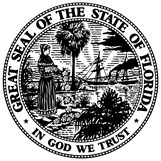State Seal

In 1985, Secretary of State George Firestone presented the revised Great Seal of the State of Florida to the Governor and the Cabinet. The previous State Seal had several errors which were corrected in in the 1985 Seal. This revised Seal has a Seminole Indian woman rather than a Western Plains Indian, the steamboat is more accurate, and the cocoa palm has been changed to a sabal palm as the Legislature prescribed in 1970.
History of the State Seal 1868-1985
The elements and basic design instructions for Florida's State Seal were established by the Legislature in 1868. Early that year, Florida's newly adopted State Constitution had directed that:"The Legislature shall, at the first session, adopt a seal for the state, and such seal shall be the size of an American silver dollar, but said seal shall not again be changed after its adoption by the Legislature."
So the Legislature, acting quickly upon the mandate, passed and sent to Governor Harrison Reed a Joint Resolution on August 6, 1868 specifying "That a Seal of the size of the American silver dollar, having in the center thereof a view of the sun's rays over a high land in the distance, a cocoa tree, a steamboat on water, and an Indian female scattering flowers in the foreground, encircled by the words, 'Great Seal of the State of Florida: In God We Trust', be and the same is hereby adopted as the Great Seal of the State of Florida." "In God We Trust" was adopted as the official state motto in the 2006 Florida Legislative Session. (Florida State Statute 15.0301)
Florida's present Constitution, (Art. II, Sec. 4), continues to require the seal to be prescribed by law. In 1970, more than 100 years after the first specifications were drawn, the Florida Legislature made one change in the official description (CH. 15.03), changing "cocoa tree" in the former language to "Sabal palmetto palm." The sabal palmetto palm had been designated as State Tree in 1953.
Through the years, interpretations of the elements of the Great Seal have differed considerably. The steamboat, for instance, has been depicted in a variety of ways. The various images of the Indian female have drawn criticism from historians conscious of her clothing. The earliest official Great Seal pictured a mountainous background, something absent from the Florida terrain. Another effort showed a feather headdress on the Indian, a blunder insomuch as Indian males wore the headdresses.

Through it all, however, the elements in the Great Seal have remained consistent.
Usage of the State Seal
Section 15.03 of the Florida Statutes in addition to specifying elements of the Great Seal, provides that the Department of State shall be the custodian of it, and that the Department of State alone has the authority to approve its use or display as defined further in Florida Administrative Rule 1-2.0021. A further provision prohibits any commercial use of the Great Seal.
To request use of the State Seal, please fill out form DS-19 and send it to:
Florida Department of State
Office of the General Counsel
500 South Bronough Street
Tallahassee, FL 32399
(850) 245-6127 - fax
